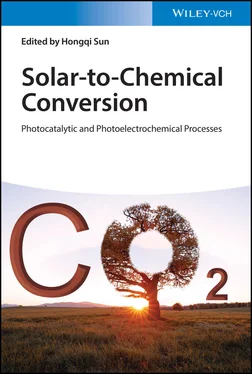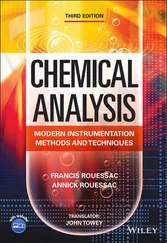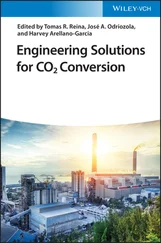Solar-to-Chemical Conversion
Здесь есть возможность читать онлайн «Solar-to-Chemical Conversion» — ознакомительный отрывок электронной книги совершенно бесплатно, а после прочтения отрывка купить полную версию. В некоторых случаях можно слушать аудио, скачать через торрент в формате fb2 и присутствует краткое содержание. Жанр: unrecognised, на английском языке. Описание произведения, (предисловие) а так же отзывы посетителей доступны на портале библиотеки ЛибКат.
- Название:Solar-to-Chemical Conversion
- Автор:
- Жанр:
- Год:неизвестен
- ISBN:нет данных
- Рейтинг книги:3 / 5. Голосов: 1
-
Избранное:Добавить в избранное
- Отзывы:
-
Ваша оценка:
- 60
- 1
- 2
- 3
- 4
- 5
Solar-to-Chemical Conversion: краткое содержание, описание и аннотация
Предлагаем к чтению аннотацию, описание, краткое содержание или предисловие (зависит от того, что написал сам автор книги «Solar-to-Chemical Conversion»). Если вы не нашли необходимую информацию о книге — напишите в комментариях, мы постараемся отыскать её.
Solar-to-Chemical Conversion — читать онлайн ознакомительный отрывок
Ниже представлен текст книги, разбитый по страницам. Система сохранения места последней прочитанной страницы, позволяет с удобством читать онлайн бесплатно книгу «Solar-to-Chemical Conversion», без необходимости каждый раз заново искать на чём Вы остановились. Поставьте закладку, и сможете в любой момент перейти на страницу, на которой закончили чтение.
Интервал:
Закладка:
10 Chapter 11Figure 11.1 (a) Schematic illustrations of different pathways for N 2reduction, including the dissociative pathway, associative alternating pathway, and associative distal pathway. Source: (a) Shipman et al. [13]. © 2017, Elsevier.Figure 11.2 (a) Schematic of the plasmon excitation‐based photocatalytic N 2reduction. (b) TEM image of the Au/TiO 2−OV NSs. (c) EPR spectra of four catalysts of TiO 2, TiO 2−OV, Au/TiO 2, and Au/TiO 2−OV. (d) Detected NH 3concentrations of four catalysts. Source: (a–d) Adapted from Yang et al. [30]. © 2018, American Chemical Society.Figure 11.3 (a) Schematic of the synthesis process of engineering NVs into g ‐C 3N 4. (b) ESR and (c) TPD spectra of the prepared g ‐C 3N 4and V− g ‐C 3N 4. Source: (a–c) Adapted from Dong et al. [43]. © 2015, Royal Society of Chemistry.Figure 11.4 (a) Schematic photocatalytic N 2reduction on ultrathin MWO‐1 nanowires. Adsorption configurations of N 2molecules with different charge dispersions on (b) defect‐rich W 18O 49, and (c) Mo‐doped W 18O 49. (d) O K‐edge XAS spectra of different photocatalysts. (e) Schematic of the PCET process for photocatalytic N 2fixation. (f) Photocatalytic NH 3yield rates with MWO-1. Source: (a–f) Adapted from Zhang et al. [53]. © 2018, American Chemical Society.Figure 11.5 (a) and (b) HAADF−STEM images and (c) EDX mapping of A‐SmOCl. (d) ESR signals and (e) O K‐edge XAS spectra of different photocatalysts. (f) In situ DRIFT spectra recorded in the N 2reduction process. Source: (a–f) Hou et al. [61]. © 2019, Elsevier.Figure 11.6 (a) SEM and (b) TEM images of the GaN NWs. (c) TEM image of Ru (5 wt%) decorated GaN NWs. Inset: the diameter distributions of Ru nanoclusters. (d) Schematic of the Schottky barrier between Ru clusters and n‐type GaN NWs. (e) Schematic illustration for the InGaN/GaN with five segments of InGaN on the template of GaN nanowire. (f) NH 3evolution rates of various photocatalysts under visible‐light illumination. Source: (a–f) Li et al. [74]. © 2017, John Wiley & Sons.Figure 11.7 (a) Schematic illustration of photocatalytic cell for N 2fixation. (b) and (c) HRTEM images of hollow Au–Ag 2O, the inset is the corresponding FFT of the nanoparticle. (d) NH 3yields and solar‐to‐ammonia (STA) efficiencies of different photocatalysts. (e) NH 3yields of Au–Ag 2O under various operating conditions. Source: (a–e) Nazemi et al. [82]. © 2019, Elsevier.Figure 11.8 (a) Schematic of N 2reduction on the aerophilic–hydrophilic interface. (b) Droplet shapes of the liquid and N 2bubble on different interfaces. (c) Interfacial water molecule spectra on the surface of Au-PTFE/TS . (d) NH 3yield rates and FEs on Au/TS and Au−PTFE/TS at different potentials. Source: (a–d) Zheng et al. [89]. © 2019, Elsevier.Figure 11.9 (a) Schematic of the synthesis steps for the Au/end−CeO 2heterojunction. (b) HAADF−STEM image and the related elemental mapping. Mechanism for N 2photo‐fixation on the Au/end−CeO 2heterojunction. The hot carrier separation behaviors on (c) the Au/end−CeO 2and (d) the core@shell nanostructures. Source: (a–d) Jia et al. [111]. © 2019, American Chemical Society.Figure 11.10 (a) Schematic of TiO 2−xH y/Fe catalyst for dual‐temperature‐zone photo‐thermal NH 3synthesis. (b) High‐resolution STEM image of TiO 2−xH y/Fe catalyst. (c) Steady‐state non‐equilibrium temperature distribution and dual‐temperature‐zone NH 3synthesis on TiO 2−xH y/Fe. (d) LTDs between hot Fe and cooling TiO 2−xH y. (e) SERS mapping of the spatial dispersion of TiO 2−xH y, Fe, and the adonitol and the detected local LTD. (f) The NH 3concentrations produced at different apparent catalyst temperatures. (g) Successive light‐on/off measurement of photo‐thermal NH 3synthesis. (h) The impressive equilibrium‐beyond reactivity of TiO 2−xH y/Fe at different pressures. Source: (a–h) Mao et al. [118]. © 2019, Elsevier.Figure 11.11 (a) HRTEM, (b) elemental mapping, and (c) HAADF−STEM images of Mo−PCN. (d) Time‐resolved fluorescence kinetics. (e) LT−FTIR spectra for N 2adsorption. (f) Charge density difference of Mo−PCN with adsorbed N 2. Source: (a–f) Guo et al. [119]. © 2019, Royal Society of Chemistry.Figure 11.12 (a) Schemcatic of designed Mo 2Fe 6S 8−Sn 2S 6biomimetic chalcogel. Source: (a) Adapted from Banerjee et al. [122]. © 2015, American Chemical Society.
11 Chapter 12Figure 12.1 (a) UV–vis DRS and (b) N 2adsorption isotherms at 77 K for MIL‐125‐NH 2and NiO/MIL‐125‐NH 2. Source: Isaka et al. [24]. © 2018, Royal Society of Chemistry.Figure 12.2 Ni K‐edge (a) XAFS and (b) FT‐EXAFS spectra of NiO/MIL‐125‐NH 2. Source: Isaka et al. [24]. © 2018, Royal Society of Chemistry.Figure 12.3 (a) TEM image, (b) HAADF‐STEM image, and (c‐f) EDX mappings of NiO/MIL‐125‐NH 2. Source: Reproduced with permission from Isaka et al. [24].Figure 12.4 (a) Time course of photocatalytic H 2O 2production catalyzed by MIL‐125‐NH 2in the presence and absence of TEOA and visible‐light irradiation ( λ > 420 nm). (b) Time courses of photocatalytic H 2O 2production catalyzed by MIL‐125‐NH 2, NiO/MIL‐125‐NH 2, and Pt/MIL‐125‐NH 2. Source: (a) Isaka et al. [24]. © 2018, Royal Society of Chemistry.Figure 12.5 (a) Time course of TEOA oxidation product formation under visible‐light ( λ > 420 nm) irradiation for MIL‐125‐NH 2. (b) Mass spectrum of the peak after photoirradiation. (c,d) Reported oxidation products of TEOA in literatures. (e) Plausible product of TEOA oxidation. Source: Isaka et al. [24]. © 2018, Royal Society of Chemistry.Figure 12.6 Time courses of H 2O 2and benzaldehyde production of (a) MIL‐125‐NH 2and (b) NiO/MIL‐125‐NH 2dispersed in an acetonitrile solution of benzyl alcohol under visible‐light irradiation ( λ > 420 nm). Source: Isaka et al. [24]. © 2018, Royal Society of Chemistry.Figure 12.7 Time courses of H 2O 2(15 mM) decomposition dissolved in 5.0 ml of acetonitrile suspension of 5.0 mg of MIL‐125‐NH 2and NiO/MIL‐125‐NH 2at 313 K. Source: Isaka et al. [24]. © 2018, Royal Society of Chemistry.Figure 12.8 EPR spectral of suspensions containing DMPO and (a) MIL‐125‐NH 2or (b) NiO/MIL‐125‐NH 2under visible‐light irradiation ( λ > 420 nm). Source: (a) Isaka et al. [24]. © 2018, Royal Society of Chemistry.Figure 12.9 (a) Digital photographs of two‐phase systems composed of an aqueous phase and a benzyl alcohol phase containing MIL‐125‐NH 2(left) and MIL‐125‐R n ( n = 4 and 7, right). (b) Photocatalytic H 2O 2production in the two‐phase system. Source: Isaka et al. [28]. © 2019, John Wiley & Sons.Figure 12.10 (a) XRD patterns and (b) UV–vis DRS for MIL‐125‐NH 2, MIL‐125‐R4, and MIL‐125‐R7. Source: Isaka et al. [28]. © 2019, John Wiley & Sons.Figure 12.11 FE‐SEM images of (a,c) MIL‐125‐NH 2and (b,d) MIL‐125‐R7 (a,b) before and (c,d) after three hours of photoirradiation ( λ > 420 nm) reaction in the two‐phase system composed of benzyl alcohol (5.0 ml) and water (2.0 ml). Source: Reproduced with permission from Isaka et al. [28].Figure 12.12 TEM images of (a,c) MIL‐125‐NH 2and (b,d) MIL‐125‐R7 (a,b) before and (c,d) after three hours of photoirradiation ( λ > 420 nm) reaction in the two‐phase system composed of benzyl alcohol (5.0 ml) and water (2.0 ml). Source: Reproduced with permission from Isaka et al. [28].Figure 12.13 TG‐DTA measurement of (a,b) MIL‐125‐NH 2, (c,d) MIL‐125‐R4, and (e,f) MIL‐125‐R7. Chemical structures of linkers in (g) MIL‐125‐NH 2, alkylated linker in (h) MIL‐125‐R4, and (i) MIL‐125‐R7. Source: Isaka et al. [28]. © 2019, John Wiley & Sons.Figure 12.14 (a) Water adsorption isotherms at 298 K for MIL‐125‐NH 2, MIL‐125‐R4, and MIL‐125‐R7. The water contact angles of (b) MIL‐125‐NH 2, (c) MIL‐125‐R4, and (d) MIL‐125‐R7. Source: (a) Isaka et al. [28]. © 2019, John Wiley & Sons; (b–d) Reproduced with permission from Isaka et al. [28].Figure 12.15 (a) Digital photograph of MIL‐125‐NH 2(left) and MIL‐125‐R7 (right) dispersed into the two‐phase system; aqueous phase (2.0 ml) was observed on top of the benzyl alcohol phase (5.0 ml). (b) Time courses of H 2O 2production under photoirradiation ( λ > 420 nm) in the two‐phase system catalyzed by 5.0 mg of catalysts. Source: (a) Reproduced with permission from Isaka et al. [28]; (b) Isaka et al. [28]. © 2019, John Wiley & Sons.Figure 12.16 Time courses of benzaldehyde formation under photoirradiation ( λ > 420 nm) of the two‐phase system composed of benzyl alcohol (5.0 ml) and water (2.0 ml) catalyzed by 5.0 mg of catalysts. Source: Isaka et al. [28]. © 2019, John Wiley & Sons.Figure 12.17 XRD patterns of MIL‐125‐NH 2and MIL‐125‐R7 after three hours of photoirradiation ( λ > 420 nm) reaction in the two‐phase system composed of benzyl alcohol (5.0 ml) and water (2.0 ml). Source: Isaka et al. [28]. © 2019, John Wiley & Sons.Figure 12.18 Recycling tests of H 2O 2production under photoirradiation ( λ > 420 nm) of the two‐phase system composed of benzyl alcohol (10.0 ml) and water (4.0 ml) catalyzed by 10.0 mg of MIL‐125‐NH 2(blue) and MIL‐125‐R7 (orange). Source: Isaka et al. [28]. © 2019, John Wiley & Sons.Figure 12.19 (a) Time courses of H 2O 2production under photoirradiation ( λ > 420 nm) of the two‐phase system composed of benzyl alcohol (5.0 ml) and water (2.0, 5.0, and 10.0 ml) catalyzed by 5.0 mg of MIL‐125‐R7. (b) Time courses of H 2O 2production under photoirradiation ( λ > 420 nm) of the two‐phase system composed of benzyl alcohol (5.0 ml) and water (2.0 ml) at different pH values (0.3, 1.3, 2.1, and 6.7) catalyzed by 5.0 mg of MIL‐125‐R7. (c) Time courses of H 2O 2production under photoirradiation ( λ > 420 nm) of the two‐phase system composed of benzyl alcohol (5.0 ml) and an aqueous phase (2.0 ml, deionized water or saturated NaCl aqueous solution) catalyzed by 5.0 mg MIL‐125‐R7. Source: Isaka et al. [28]. © 2019, John Wiley & Sons.Figure 12.20 N 2adsorption isotherms at 77 K for MIL‐125‐NH 2, MIL‐125‐R4, and MIL‐125‐R7. Source: Isaka et al. [28]. © 2019, John Wiley & Sons.Figure 12.21 Photocatalytic H 2O 2production with (a) linker‐alkylated MOF: MIL‐125‐R7 and (b) cluster‐alkylated MOF: OPA/MIL‐125‐NH 2. Source: Kawase et al. [31]. © 2019, Royal Society of Chemistry.Figure 12.22 (a) XRD patterns and (b) UV–vis DRS of MIL‐125‐NH 2and OPA/MIL‐125‐NH 2. Source: Kawase et al. [31]. © 2019, Royal Society of Chemistry.Figure 12.23 N 2adsorption isotherms at 77 K for MIL‐125‐NH 2and OPA/MIL‐125‐NH 2. Source: Kawase et al. [31]. © 2019, Royal Society of Chemistry.Figure 12.24 (a) TG and (b) DTA profiles of OPA/MIL‐125‐NH 2. (c) Chemical structures of alkylated clusters in OPA/MIL‐125‐NH 2. Source: Kawase et al. [31]. © 2019, Royal Society of Chemistry.Figure 12.25 FTIR spectra of (a) MIL‐125‐NH 2, OPA/MIL‐125‐NH 2, and (b) OPA. Source: Kawase et al. [31]. © 2019, Royal Society of Chemistry.Figure 12.26 (a) XPS spectra of Ti 2p in MIL‐125‐NH 2and OPA/MIL‐125‐NH 2. (b) XPS spectra of P 2p in MIL‐125‐NH 2and OPA/MIL‐125‐NH 2before and after etching. Source: Kawase et al. [31]. © 2019, Royal Society of Chemistry.Figure 12.27 (a) Water contact angle of OPA/MIL‐125‐NH 2. (b) Time courses of H 2O 2production of OPA/MIL‐125‐NH 2under photoirradiation ( λ > 420 nm) in the two‐phase system. Source: (a) Kawase et al. [31]. © 2019, Royal Society of Chemistry; (b) Reproduced with permission from Kawase et al. [31].Figure 12.28 Time courses of benzaldehyde production of OPA/MIL‐125‐NH 2under photoirradiation ( λ > 420 nm) in the two‐phase system. Source: Kawase et al. [31]. © 2019, Royal Society of Chemistry.Figure 12.29 Time courses of H 2O 2production under photoirradiation ( λ > 420 nm) of a single‐phase system composed of an acetonitrile solution (5.0 ml) of BA (1.0 ml) catalyzed by 5.0 mg of catalysts. Source: Kawase et al. [31]. © 2019, Royal Society of Chemistry.Figure 12.30 Recycling tests of MIL‐125‐NH 2, MIL‐125‐R7, and OPA/MIL‐125‐NH 2. Source: Kawase et al. [31]. © 2019, Royal Society of Chemistry.Figure 12.31 XRD patterns of OPA/MIL‐125‐NH 2before and after reaction. Source: Kawase et al. [31]. © 2019, Royal Society of Chemistry.Figure 12.32 N 2adsorption isotherms at 77 K for OPA/MIL‐125‐NH 2before and after the reaction. Source: Kawase et al. [31]. © 2019, Royal Society of Chemistry.
Читать дальшеИнтервал:
Закладка:
Похожие книги на «Solar-to-Chemical Conversion»
Представляем Вашему вниманию похожие книги на «Solar-to-Chemical Conversion» списком для выбора. Мы отобрали схожую по названию и смыслу литературу в надежде предоставить читателям больше вариантов отыскать новые, интересные, ещё непрочитанные произведения.
Обсуждение, отзывы о книге «Solar-to-Chemical Conversion» и просто собственные мнения читателей. Оставьте ваши комментарии, напишите, что Вы думаете о произведении, его смысле или главных героях. Укажите что конкретно понравилось, а что нет, и почему Вы так считаете.


![Евгений Матерёв - Музеи… или вдохновляющая музыка The Chemical Brothers [litres самиздат]](/books/437288/evgenij-materev-muzei-ili-vdohnovlyayuchaya-muzyka-th-thumb.webp)









